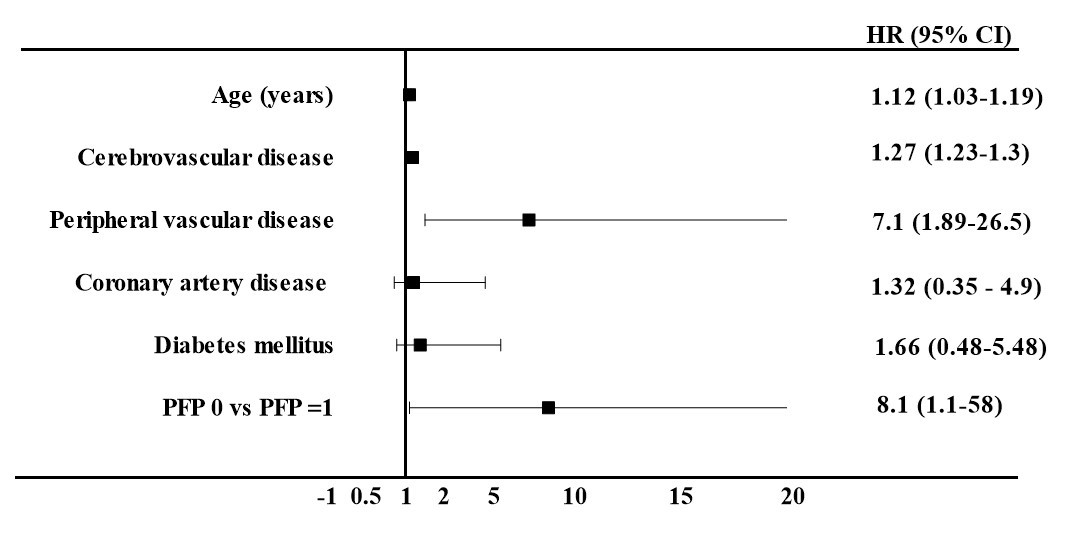Increased Mortality After Kidney Transplantation in Mildly Frail Recipients: Need for Pretransplant Intervention
1Nephrology, Hospital del Mar, Barcelona, Spain, 2Rehabilitation, Hospital del Mar, Barcelona, Spain, 3Geriatrics, Hospital del Getafe, Getafe, Spain
Meeting: 2022 American Transplant Congress
Abstract number: 963
Keywords: Kidney, Mortality, Outcome, Risk factors
Topic: Basic & Clinical Science » Basic & Clinical Science » 20 - VCA
Session Information
Session Time: 7:00pm-8:00pm
 Presentation Time: 7:00pm-8:00pm
Presentation Time: 7:00pm-8:00pm
Location: Hynes Halls C & D
*Purpose: Frailty is associated with a higher rate of complications and mortality after kidney transplantation (KT). Physical Frailty Phenotype (PFP) is the most used frailty instrument among KT recipients, it comprises 5 criteria and classifies patients as frail if they have ≥3. We aimed to determine the impact of scoring 1 PFP criterion (mild frailty) on transplant outcomes
*Methods: We have prospectively followed 449 KT candidates evaluated for frailty by PFP at the time of inclusion on the KT waiting list. Patients were classified as follows: 0, robust; 1, pre-frail-1; 2, pre-frail-2; and ≥3, frail. A prospective longitudinal study was performed in all patients in the cohort who underwent KT. Clinical outcomes and survival after transplantation according to frailty status at listing was assessed.
*Results: 71.3% of total listed cohort resulted to be pre-frail (one criterion 41%, two criteria 19.8%) or frail (10.5%). Disparities were observed between sexes, with 5.2% of men and 21.9% of women being frail (p<0.01). During the study period (median 26 months [IQR 16-39]), 296 patients got a KT and 153 remained listed. Patients who did not get transplanted were more frequently frail (16.3 vs 7.4%, p=0.013). Frail patients had more hospital admissions during the 1st year after listing (43.4% if PFP ≥1 vs 20.8% if PFP=0) and more cardiovascular events or major infectious events. In a multivariate model including only patients scoring 0 (robust) or prefail-1-criterion (n=217), older age, previous cerebrovascular disease, peripheral vascular disease and mild pre-frailty were independent risk factors for mortality after KT (Figure).
*Conclusions: Frailty is frequent in KT candidates, more frequent in women than men. Frail patients have less chances to receive a KT. KT candidates are frequently listed with one (out of five) frailty criterion, and this has an independent impact on patient survival after KT. A pre-transplant clinical framework for multimodal prehabilitation interventions to mitigate the effects of frailty and poor fitness after KT may be justified even in mildly pre-frail candidates
To cite this abstract in AMA style:
Santos JPascual, Arias-Cabrales C, Redondo-Pachón D, Burballa C, Buxeda A, Bach A, Faura A, Marco E, Rodríguez-Mañas L, Crespo M, Pérez-Sáez MJ. Increased Mortality After Kidney Transplantation in Mildly Frail Recipients: Need for Pretransplant Intervention [abstract]. Am J Transplant. 2022; 22 (suppl 3). https://atcmeetingabstracts.com/abstract/increased-mortality-after-kidney-transplantation-in-mildly-frail-recipients-need-for-pretransplant-intervention/. Accessed December 17, 2025.« Back to 2022 American Transplant Congress

